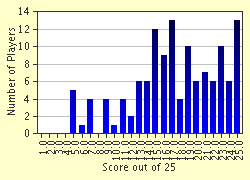Quiz Answer Key and Fun Facts
1. Who was the Belgian consul in China from 1896 till 1902? He helped the Belgian industrialists to win the license to build the Chinese railroads.
2. In 1903 started a new tradition in a small village in the province of Hainaut: young virgins invite all single men for coffee and cake. In which village does this feast take place every Whit Monday?
3. Who was the mayor of Brussels during World War I? He is best known for the following incident on August 20th, 1914. When a German officer started negotiating food supplies while displaying his gun, this mayor showed a pencil in response.
4. October 12th, 1915. In Brussels the German occupation force executed an English nurse, accused of helping wounded English and French soldiers to escape. Who was she?
5. Up till 1919, Belgium had a land border with five countries: the Netherlands, Germany, Luxemburg, France and a very small independent country named "Independent Moresnet". This last country had a territory of only 33 hectares, and was situated near the Belgian-Dutch-German border.
6. Which Belgian city organised the Olympic Games in 1920?
7. Fernande Voisin (born on June 21st, 1917), Gilberte Voisin (born on June 20th, 1919), Albert Voisin (born on September 3rd, 1921), Andrée Degeimbre (born on April 19th, 1918) and Gilberte Degeimbre (born on August 13th, 1923) were good friends when something changed their lives completely. Starting on November 29th, 1932, these five children said they caught a glimpse of Our Lady 33 times. In which Belgian village did these miracles happen?
8. August 29th, 1935. The Belgian King Leopold III and his wife are victims of a car accident. Leopold is not injured, but the Queen dies on the spot. Who was this Belgian Queen?
9. April 5th, 1943. A squadron of American bombers missed their target and bombed by accident the centre of a village in the province of Antwerp, instead of the Erla factory based on its outskirts. In which village did this error make at least 830 innocent victims?
10. Which Belgian politician was the first president of the General Assembly of the United Nations?
11. In 1946 the comic strip series by the name of Tintin was launched. What is the real name (not the pseudonym) of the author?
12. Many people think of this movie director as being a Frenchmen. But in fact this scientist did have a Belgian passport. Who was this man, most famous for his documentary movies on volcanic activity?
13. What was the major news fact in Belgium and the Netherlands on February 1st, 1953?
14. Which monument with a height of 102 m (about 110 yards) was placed in Brussels in 1958?
15. The Nobel Peace Prize in 1958 was awarded to the Belgian monk Georges Pire. Of which order is he a member?
16. September 17th, 1964. In Ghent the famous novellist Jean Raymond De Kremer, dies. Under what pseudonym did he write his masterpiece "Malpertuis"?
17. The painter we are looking for in this question died on August 15th, 1967. He was one of the major Belgian surrealist painters. His best known work is a painting of a pipe titled "Ceci n'est pas une pipe" ("This is not a pipe"). With this title he meant that the painting is not a pipe, but only the picture of a pipe - or "how to paint philosophy". Who was this painter?
18. July 21st, 1969. A young Belgian cyclist wins his first Tour de France. Who was this cyclist, who won in total five times the Tour de France, five times the Giro d'Italia and once the Vuelta d'España?
19. In 1975 the first and only art object was placed on the moon. This object is a small sculpture by the Belgian artist Paul Van Hoeydonck. What is the title of this sculpture?
20. A Belgian singer-songwriter died near Paris in 1978. He is famous for songs as "Ne me quitte pas" ("Don't Leave Me Now") and "Le plat pays" ("The Flat Country"). What is his name?
21. Belgium has lost the Eurovision Song Contest several times. The first Belgian competitor to win the contest was a young girl, born Sandra Calderone. She won in 1986 with what stage name?
22. March 6th, 1987. The ferry "Herald of Free Enterprise" sinks just off Zeebrugge. What day of the week did this catastrophe take place?
23. A Belgian actor played the title role in the Flemish movie "Daens" (nominated for an Oscar in 1993) and was the leading actor in the Dutch movie "Karakter" ("Character") (1997), which won an Oscar. Who is this actor, whom you'll know best from his role of Angelo Ledda in the Flemish movie "Memory of a Killer" (2003)?
24. Belgium won the Fed Cup for the very first time in 2001. Which country lost in the final?
25. The man we are looking for in this last question is probably the man with the most appearances on Flemish television. He presented the weather forecast from 1953 till 1990. He died September 22nd, 2003. What is his name?
Source: Author
JanIQ
This quiz was reviewed by FunTrivia editor
bloomsby before going online.
Any errors found in FunTrivia content are routinely corrected through our feedback system.

